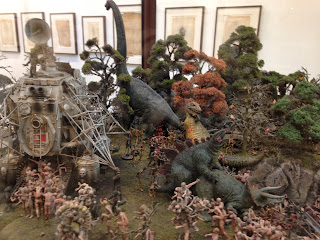 |
| Photo:Alejandra de Argos |
The Chapmans are part of the Young British Artists group, and a large part of their work is inspired by the Old Master Francisco de Goya. The artists’ desire to recreate Goya’s “flat” paintings in three dimensions is evident among the work on display.

These photos show Goya’s etching on the right, and the related Chapman sculpture on the left. Although these works were not included in this exhibition at London’s Serpentine Gallery, it does go to show the relevance and modernity of Goya’s work, which dates back to around 1810.
 |
| Photo:Alejandra de Argos |
A number of years ago the two brothers obtained one of Goya’s series of anti-war etchings titled “The Disasters of War”, and replaced the victims with clowns and puppets: an example of the irreverent black humour so often present in their work.
Fucking Hell by Jake and Dinos Chapman
Goya’s influence on the Chapmans continues to be seen in Hell, a piece consisting of apocalyptic landscapes within large glass cabinets, where small figurines of terrifying Nazi soldiers are engaged in violent acts with each other. It draws parallels with Goya’s The Disasters of War in that there is some ambiguity in identifying the victims and the perpetrators, in a way that criticizes the war atrocities of Spanish Independence, the Holocaust and other bloody conflicts from history. This sharp criticism is mixed with a tone of mockery, with the inclusion of Ronald McDonald as a victim of crucifixion by the Nazis or as torturer: a critique of globalization, fast-food culture, US imperialism and its far-reaching consequences.
 |
| Photo:Serpentine Gallery |
 |
| Photo: Alejandra de Argos |
Sex, religion, morality and culture are the main themes dealt with in their work, and their tone is grotesque, aggressive, provocative. In particular, references to morality can be seen in a series of life-size figures dressed in white tunics and hoods, looking down at what lies before them - a nod to Goya’s etchings depicting the Spanish Inquisition (this dress is also typically seen among penitent brotherhoods during Spain’s Holy Week). With these etchings Goya was speaking out against the

Inquisition and superstition in general. The Chapman brothers are also creating an analogy with the robes worn by the Ku Klux Klan, the American far-right white supremacy group. This serious ideological tone is somewhat eased by the smiley faces present on the tunics, and by their grotesque sandals and colourful socks.
It’s difficult to explain. What one finds here is ugly, aggressive, violent and unpleasant. The art mercilessly forces you to face the basest and crudest sides of human beings, leaving out civilization, culture or any of the other more constructive capacities of humanity which differentiate us from the rest of the animal kingdom. A real-world depiction, in all its rawness, of Twain’s quote: “Of all the creatures that were made, man is the most detestable. Of the entire brood he is the only one--the solitary one--that possesses malice.”
Of all the exhibits on display, I most enjoyed the oil paintings. The majority of them belong to the White Cube gallery.
 |
| Foto: Alejandra de Argos |
 |
| Photo: Alejandra de Argos |
 |
| Photo: Alejandra de Argos |


Duchamp famously said that art is in the eye of the beholder, not in the artwork itself. Art is and has always been a means of communication between the artist and the viewer. Francisco de Goya, the Chapman brothers: one message, two centuries...
Jake and Dinos Chapman. "Come and See". From November 29, 2013 to February 9, 2014.

 Cambiar a versión en Español
Cambiar a versión en Español






1 comment:
This exhibition looks fascinating (although grotesque!) If I get a chance in London I will definitely be visiting it this weekend!
Post a Comment
Muchas gracias por compartir tus comentarios